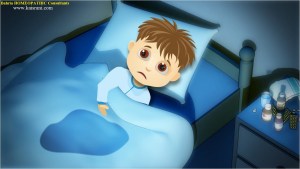Tonsillitis is an infection of the tonsils and will often, but not necessarily, cause a sore throat and fever.
Types of Tonsillitis
There are 3 main types of tonsillitis: acute, subacute and chronic. Acute tonsillitis can either be bacterial or viral (75%) in origin. Subacute tonsillitis (which can last between 3 weeks and 3 months) is caused by the bacterium Actinomyces. Chronic tonsillitis, which can last for long periods if not treated, is almost always bacterial.
Symptoms of Tonsillitis
Symptoms of tonsillitis include a severe sore throat (which may be experienced as referred pain to the ears), painful/difficult swallowing, headache, fever and chills, and change in voice causing a “hot potato” voice. Tonsillitis is characterized by signs of red, swollen tonsils which may have a purulent exudative coating of white patches (i.e. pus). There may be enlarged and tender neck cervical lymph nodes.
Causes of Tonsillitis
Bacterial tonsillitis may be caused by Group A streptococcal bacteria,[1] resulting in strep throat.[1] Viral tonsillitis may be caused by numerous viruses[1] such as the Epstein-Barr virus[1] (the cause of infectious mononucleosis)[2] or the Adenovirus.[1]
Sometimes, tonsillitis is caused by a superinfection of spirochaeta and treponema, in this case called Vincent’s angina or Plaut-Vincent angina.[3]
Although tonsillitis is associated with infection, it is currently unknown if the swelling and other symptoms are caused by the infectious agents themselves, or by the host immune response to these agents. Tonsillitis may be a result of aberrant immune responses to the normal bacterial flora of the nasopharynx.
Treatment of Tonsillitis
Treatments of tonsillitis consist of pain management medications[4] and lozenges.[5] If the tonsillitis is caused by bacteria, then antibiotics are prescribed, with penicillin being most commonly used.[6] Erythromycin is used for patients allergic to penicillin.
In many cases of tonsillitis, the pain caused by the inflamed tonsils warrants the prescription of topical anesthetics for temporary relief. Viscous lidocaine solutions are often prescribed for this purpose.
Ibuprofen or other analgesics can help to decrease the edema and inflammation, which will ease the pain and allow the patient to swallow liquids sooner.[4]
When tonsillitis is caused by a virus, the length of illness depends on which virus is involved. Usually, a complete recovery is made within one week; however, some rare infections may last for up to two weeks.
Chronic cases may indicate tonsillectomy (surgical removal of tonsils) as a choice for treatment[7]
Additionally, gargling with a solution of warm water and salt may reduce pain and swelling.[8]
Homeopathy Treatment for Tonsillitis
Keywords: homeopathy, homeopathic, treatment, cure, remedy, remedies, medicine
Homeopathy treats the person as a whole. It means that homeopathic treatment focuses on the patient as a person, as well as his pathological condition. The homeopathic medicines are selected after a full individualizing examination and case-analysis, which includes the medical history of the patient, physical and mental constitution, family history, presenting symptoms, underlying pathology, possible causative factors etc. A miasmatic tendency (predisposition/susceptibility) is also often taken into account for the treatment of chronic conditions. A homeopathy doctor tries to treat more than just the presenting symptoms. The focus is usually on what caused the disease condition? Why ‘this patient’ is sick ‘this way’. The disease diagnosis is important but in homeopathy, the cause of disease is not just probed to the level of bacteria and viruses. Other factors like mental, emotional and physical stress that could predispose a person to illness are also looked for. No a days, even modern medicine also considers a large number of diseases as psychosomatic. The correct homeopathy remedy tries to correct this disease predisposition. The focus is not on curing the disease but to cure the person who is sick, to restore the health. If a disease pathology is not very advanced, homeopathy remedies do give a hope for cure but even in incurable cases, the quality of life can be greatly improved with homeopathic medicines.
The homeopathic remedies (medicines) given below indicate the therapeutic affinity but this is not a complete and definite guide to the homeopathy treatment of this condition. The symptoms listed against each homeopathic remedy may not be directly related to this disease because in homeopathy general symptoms and constitutional indications are also taken into account for selecting a remedy. To study any of the following remedies in more detail, please visit the Materia Medica section at www.kaisrani.com.
None of these medicines should be taken without professional advice and guidance.
Homeopathy Remedies for Tonsillitis :
Acon., aesc., ail., alumn., aml-n., anan., ant-t., anthr., apis., ars., bad., bapt., bar-c., bar-m., bell., benz-ac., berb., bufo., canth., caps., cedr., cham., chel., chen-a., colch., crot-h., cupr., cur., dulc., ferr-p., fl-ac., gels., guai., ham., hep., ign., iod., kali-bi., kali-chl., kali-p., lac-c., lach., lyc., merc., merc-cy., merc-d., merc-i-f., merc-i-r., naja., nat-s., nit-ac., phyt., plb., psor., puls., sabad., sang., sep., sil., staph., still., sulph., tarent., ust., verat., vesp., zinc.
Complications for Tonsillitis
An abscess may develop lateral to the tonsil during an infection, typically several days after the onset of tonsillitis. This is termed a peritonsillar abscess (or quinsy). Rarely, the infection may spread beyond the tonsil resulting in inflammation and infection of the internal jugular vein giving rise to a spreading septicaemia infection (Lemierre’s syndrome).
In chronic/recurrent cases (generally defined as seven episodes of tonsillitis in the preceding year, five episodes in each of the preceding two years or three episodes in each of the preceding three years),[9][10][11] or in acute cases where the palatine tonsils become so swollen that swallowing is impaired, a tonsillectomy can be performed to remove the tonsils. Patients whose tonsils have been removed are certainly still protected from infection by the rest of their immune system.
Bacteria feeding on mucus which accumulates in pits (referred to as “crypts”) in the tonsils may produce whitish-yellow deposits known as tonsilloliths. These may emit an odour due to the presence of volatile sulfur compounds.
Hypertrophy of the tonsils can result in snoring, mouth breathing, disturbed sleep, and obstructive sleep apnea, during which the patient stops breathing and experiences a drop in the oxygen content in the bloodstream. A tonsillectomy can be curative.
In very rare cases, diseases like rheumatic fever[12] or glomerulonephritis[13] can occur. These complications are extremely rare in developed nations but remain a significant problem in poorer nations.[14][15]
References
- ^ a b c d e Putto A (1987). “Febrile exudative tonsillitis: viral or streptococcal?”. Pediatrics 80 (1): 6–12. PMID 3601520.
- ^ Renn CN, Straff W, Dorfmüller A, Al-Masaoudi T, Merk HF, Sachs B (2002). “Amoxicillin-induced exanthema in young adults with infectious mononucleosis: demonstration of drug-specific lymphocyte reactivity”. Br. J. Dermatol. 147 (6): 1166–70. doi:. PMID 12452866. -Renn studied 4 patients who where treated amoxicillin for throat infection and lymphadenopathy. Infectious mononucleosis was present in the patient’s blood due to trace of Epstein-Barr antibodies. The three tests performed where the patched test, intracutaneous test, and lymphocyte transformation test. The results of the patched test that pointed to amoxicillin as the caused of their rash were 1 out of 4 patients. The intracutaneous showed 2 out of 4 patients with positive results that pointed to amoxicillin. The LTT results showed 3 out of 4 that pointed to amoxicillin
- ^ Van Cauwenberge P (1976). “[Significance of the fusospirillum complex (Plaut-Vincent angina)]” (in Dutch; Flemish). Acta Otorhinolaryngol Belg 30 (3): 334–45. PMID 1015288. – fusospirillum complex (Plaut-Vincent angina) Van Cauwenberge studied the tonsils of 126 patients using direct microscope observation. The results showed that 40% of acute tonsillitis was caused by Vincent’s agina and 27% of chronic tonsillitis was caused by Spirochaeta
- ^ a b Boureau, F. et al. “Evaluation of Ibuprofen vs Paracetamol Analgesic Activity Using a Sore Throat Pain Model”. Clinical Drug Investigation 17 year=1999: 1–8. – Boureau studied 113 patients who saw 19 physicians in France. Patients were give Ibuprofen 400mg or Paracetamol 1000mg randomly. Pain intensity, difficulty swallowing, and global pain relief were use to measure in hourly increments until 6 hours after patients first dose. The results showed that Ibuprofen better than Paracetamol in all three categories
- ^ Praskash, T. et al (2001). “Koflet lozenges in the Treatment of Sore Throat”. The Antiseptic 98: 124–127. – The efficacy of Koflet Lozenges was evaluated by symptomatic relief of pain. The 48 patients were examined by the Physicians and given a scale rating from 0-3. 0 stating no signs and symptoms and 3 being the worse. The results showed patients with pharyngitis 95% of the patient with positive feedbacks. Tonsillitis patients and patients with both symptoms gave 100% positive feedbacks
- ^ Touw-Otten FW, Johansen KS (1992). “Diagnosis, antibiotic treatment and outcome of acute tonsillitis: report of a WHO Regional Office for Europe study in 17 European countries”. Fam Pract 9 (3): 255–62. doi:. PMID 1459378. – 17 European Countries had a minimum of 10 physicians each that participated in a studied that involved 4094 patients that they had seen from Nov 1989 to May 1990. Sore throat, redness and swelling of tonsils, pus on tonsils, enlarge regional lymph nodes, or fever. Bacterial and serology test were performed to determined antibiotics usage. Antibiotics results had 2334 out of 3646 patient using penicillin. 343 out of the 3646 used amoxicillin and 554 out of 3646 used macrolides
- ^ Paradise JL, Bluestone CD, Bachman RZ, et al (1984). “Efficacy of tonsillectomy for recurrent throat infection in severely affected children. Results of parallel randomized and nonrandomized clinical trials”. N. Engl. J. Med. 310 (11): 674–83. PMID 6700642. – Paradise studied 187 children with tonsillectomy or tonsillectomy and adenoidectomy. 91 children were randomly put in surgical and non-surgical groups. The other 96 were place by parent’s choice. The results favored the surgical group on reoccurrence of throat infections during their initial and second year follow-up where the data was collected. While non-surgical groups did better in the long run. 13 out of the 95 surgical group encountered surgical complications after their second year follow up
- ^ Tonsillitis: Self-care – MayoClinic.com
- ^ (January 1999) “6.3 Referral Criteria for Tonsillectomy“, Management of Sore Throat and Indications for Tonsillectomy. Scottish Intercollegiate Guidelines Network. ISBN 1-899893-66-0. – notes though that these criteria “have been arrived at arbitrarily” from:
Paradise JL, Bluestone CD, Bachman RZ, et al (1984). “Efficacy of tonsillectomy for recurrent throat infection in severely affected children. Results of parallel randomized and nonrandomized clinical trials”. N. Engl. J. Med. 310 (11): 674–83. PMID 6700642. - ^ Paradise JL, Bluestone CD, Colborn DK, Bernard BS, Rockette HE, Kurs-Lasky M (2002). “Tonsillectomy and adenotonsillectomy for recurrent throat infection in moderately affected children”. Pediatrics 110 (1 Pt 1): 7–15. doi:. PMID 12093941. – this later study by the same team looked at less severely affected children and concluded “modest benefit conferred by tonsillectomy or adenotonsillectomy in children moderately affected with recurrent throat infection seems not to justify the inherent risks, morbidity, and cost of the operations”
- ^ Wolfensberger M, Mund MT (2004). “[Evidence based indications for tonsillectomy]” (in German). Ther Umsch 61 (5): 325–8. PMID 15195718. – review of literature of the past 25 years concludes “No consensus has yet been reached, however, about the number of annual episodes that justify tonsillectomy”
- ^ Del Mar CB, Glasziou PP, Spinks AB (2004). “Antibiotics for sore throat“. Cochrane Database Syst Rev (2): CD000023. doi:. PMID 15106140. – Meta-analysis of published research
- ^ Zoch-Zwierz W, Wasilewska A, Biernacka A, et al (2001). “[The course of post-streptococcal glomerulonephritis depending on methods of treatment for the preceding respiratory tract infection]” (in Polish). Wiad. Lek. 54 (1-2): 56–63. PMID 11344703.
- ^ Ohlsson, A. (September 28 2004). “Antibiotics for sore throat to prevent rheumatic fever: Yes or No? How the Cochrane Library can help“. CMAJ 171 (7): 721. doi:. PMID 15451830. – Canadian Medical Association Journal commentary on Cochrane analysis
- ^ “Treatment of sore throat in light of the Cochrane verdict: is the jury still out?” (2002). MJA 177 (9): 512–515. – Medical Journal of Australia commentary on Cochrane analysis
Related posts:


